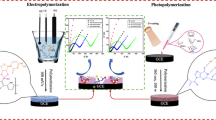Abstract
Covalent molecularly imprinted polymer (CMIP) for naringin was prepared with a conventional radical bulk polymerization by utilizing 4-vinylphenylboronic acid as a functional monomer and ethylene glycol dimethacrylate (EDMA) as a cross-linking agent. Properties such as adsorption dynamics, special binding, and selective recognition ability were evaluated. The results revealed that the CMIP possessed specific recognition ability and high molecular selectivity in contrast with a non-imprinted polymer in methanol-phosphate buffer (pH 8.0) (7/3, v/v), and the maximum equilibrium adsorption amount of CMIP reached 64.80 μmol.g−1. The adsorption equilibrium could be achieved within 3 h, which indicated that the adsorption dynamic was relatively fast. The CMIP was further employed as a sorbent of solid phase extraction (SPE) to directly separate naringin from Exocarpium citri grandi extract. The results showed that the CMIP could separate and enrich naringin from E. citri grandi extract effectively, and the special binding was calculated to be about 72 % of the total adsorption on the SPE cartridges.






Similar content being viewed by others
References
Beltran A, Marce RM, Cormack PAG, Borrull F (2010) Synthetic approaches to parabens molecularly imprinted polymers and their applications to the solid-phase extraction of river water samples. Anal Chim Acta 677:72–78
Shen ZL, Yuan D, Su QD, Zhang H, Wang J, Zhu JH, Liu YM (2011) Selective solid-phase extraction using molecularly imprinted polymer for analysis of methamidophos in water and soil samples. Biosci Biotechnol Biochem 75:473–479
Baggiani C, Baravalle P, Giraudi G, Tozzi C (2007) Molecularly imprinted solid-phase extraction method for the high-performance liquid chromatographic analysis of fungicide pyrimethanil in wine. J Chromatogr A 1141:158–164
Advincula RC (2011) Engineering molecularly imprinted polymer (MIP) materials: developments and challenges for sensing and separation technologies. Korean J Chem Eng 28:1313–1321
Barde LN, Ghule MM, Roy AA, Mathur VB, Shivhare UD (2013) Development of molecularly imprinted polymer as sustain release drug carrier for propranolol HCL. Drug Dev Ind Pharm 39:1247–1253
He JF, Zhu QH, Deng QY (2007) Investigation of imprinting parameters and their recognition nature for quinine-molecularly imprinted polymers. Spectrochim Acta A 67:1297–1305
Mayes AG, Whitcombe MJ (2005) Synthetic strategies for the generation of molecularly imprinted organic polymers. Adv Drug Deliv Rev 57:1742–1778
Jagetia GC, Reddy TK (2005) Modulation of radiation-induced alteration in the antioxidant status of mice by naringin. Life Sci 77:780–794
Zhai YK, Niu YB, Pan YL, Li CR, Wu XL, Mei QB (2013) Effects of naringin on proliferation, differentiation and maturation of rat calvarial osteoblasts in vitro. China J Chin Mater Med 38:105–111 (in China)
Okutucu B, Önal S (2011) Molecularly imprinted polymers for separation of various sugars from human urine. Talanta 87:74–79
Hqupt K, Mosbach K (2000) Molecularly imprinted polymers and their use in biomi-metic sensors. Chem Rev 100:2495–2504
Bitar A, Fessi H, Elaissari A (2012) Synthesis and characterization of thermally and glucose-sensitive poly N-vinylcaprolactam-based microgels. J Biomed Nanotechnol 8:709–719
Lin ZA, Pang JL, Lin Y, Huang H, Cai ZW, Zhang L, Chen GN (2011) Preparation and evaluation of a phenylboronate affinity monolith for selective capture of glycoproteins by capillary liquid chromatography. Analyst 136:3281–3288
Sellergren B, Lepistoe M, Mosbach K (1988) Highly enantioselective and substrate-selective polymers obtained by molecular imprinting utilizing noncovalent interactions. NMR and chromatographic studies on the nature of recognition. J Am Chem Soc 110:5853–5860
Lee SH, Doong RA (2012) Adsorption and selective recognition of 17 β-estradiol by molecularly imprinted polymers. J Polym Res 19:9939
Wulff G (1982) Selective binding to polymers via covalent bonds. Pure Appl Chem 54:2093–2102
Wang X, Tang Q, Wang Q, Qiao X, Xu Z (2013) Study of a molecularly imprinted solid-phase extraction coupled with high-performance liquid chromatography for simultaneous determination of trace trichlorfon and monocrotophos residues in vegetables. J Sci Food Agric. doi:10.1002/jsfa.6429
Xu L, Xu ZF (2012) Molecularly imprinted polymer based on multiwalled carbon nanotubes for ribavirin recognition. J Polym Res 19:9942
Xu L, He JF (2010) Preparation of hydrophilic molecularly imprinted nano-spheres and the properties on the drug release and recognition. Acta Scientiarum Natralium Universitatis Sunyatseni 49:61–64 (in Chinese)
Acknowledgments
The authors were grateful to the National Natural Science Foundation of China (No, 81303199) and Distinguished Young Talents in Higher Education of Guangdong, China (No, K5090006) for the financial support to the research.
Author information
Authors and Affiliations
Corresponding author
Rights and permissions
About this article
Cite this article
Yang, Wl., Huang, Sm., Wu, Qz. et al. Properties evaluation and separation application of naringin-imprinted polymers prepared by a covalent imprinting method based on boronate ester. J Polym Res 21, 383 (2014). https://doi.org/10.1007/s10965-014-0383-x
Received:
Accepted:
Published:
DOI: https://doi.org/10.1007/s10965-014-0383-x




